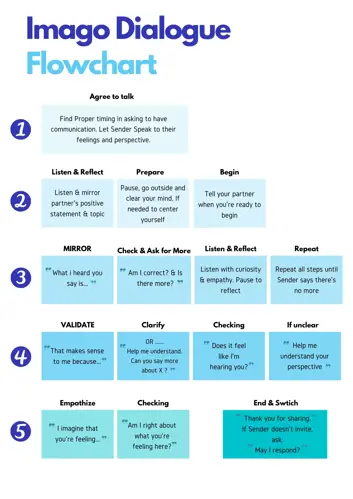A relationship has the potential to create a deep sense of happiness, love and companionship. Everyone hopes for the best when starting out in a relationship, but some people find their relationships follow frustratingly fixed patterns of interaction that evoke feelings of anger, confusion and sadness. The path to relationship success can be a very rocky road at times.
To make a relationship work, it takes understanding, communication, and mutual commitment. If your relationship is going through a rough patch, these are some of the most effective ways to ensure that you and your partner get back on track, and stay the course.
Step 1: Reinvigorate your connection
Boredom plays an important role in declining relationship satisfaction. Research shows that being bored in a relationship today can predict dissatisfaction 9 years from now. It’s not just conflict that you need to pay attention to though, but levels of engagement.
Remember how you felt when you first met your partner, and the joy of discovering who she or he was as a person? Too many of us, caught in day-to-day stresses, the distractions of social media, and binge-watching Netflix forget the simple pleasure of connecting through conversation.
Curiosity about each other fuels intimacy: making time for deep, personal talks with your partner can bring you closer together, and rekindle your interest in one another.
Find out more about your partner’s childhood, previous relationships, life experiences, and passions. Pay attention to what makes them feel happy, what upsets them and how they show affection. Ask your partner directly what makes them feel good about their relationship with you – you may find it’s very different to what makes you feel good about your relationship!
In turn, share your hopes, desires, experiences and preferences with your partner. Rather than seeing differences as a potential source of conflict, make a commitment to exploring, respecting and celebrating one another’s unique perspectives and approach to life.
Step 2: Transform arguments into opportunities for relationship growth
All couples will argue over the course of a relationship. Good communication is the key to transforming disagreements from a point of relationship conflict and division to an opportunity for change and growth.

A common stumbling block for couples is the demand/withdrawal cycle of communication. This happens when one partner brings up something that’s bothering them, and the other person dismisses their concerns (verbally or with body language), or retreats into silence. The demand/withdrawal pattern of communication is incompatible with a happy relationship – in fact, it’s a reliable predictor of separation.
If this is a pattern in your relationship – and anyone can play either role – it’s important to work at identifying and stopping it, ideally in a moment of calm, not agitation. The key is to let go of the need to be right in an argument, and resisting the urge to resort to tit-for-tat responses that we may reflexively use when we are really riled up and in pain.
- Stop the spiral before it starts: since these are repetitive fights, they often have predictable triggers—it could be a disagreement over how to handle one of your kids, your in-laws’ pending visit, or money being tight—so talk about it calmly first. If you see signs of a brewing fight—a shift in tone or body language—stop and take a break. Yes, it’s a time-out for grown-ups, so each partner can collect his or her thoughts. Take as much time as you need to cool off, and then continue the discussion.
- Work on expressing yourself in ways that won’t lead to escalation. Substitute less inflammatory words, and make sure you’re not launching personal attacks. Instead of “You need to change” try “Can you explain why you did that?”
- It takes two to both escalate and de-escalate a conflict. Get a handle on your own negative emotions, and figure out how to regain your own self-control and help your partner regain his or hers.
Step 3: Prioritise resolution in conflict situations
By focusing on what needs to be done to reduce the mutual hostility that ramps up when you’re fighting, you’re protecting the long-term success of your partnership. Sustained hostility doesn’t leave room for authentic discussion and constructive criticism, which are essential tools for couples to resolve their issues and reconcile any differences.
When you do disagree with your partner, listen carefully and try to understand how they might be experiencing things differently from you. Try talking about how you feel, rather than what the other person has done wrong. Blame can be toxic to relationship health. Rather than just focusing on who’s in the wrong, recovery from conflict begins with both partners acknowledging that the problem is a shared one, and taking responsibility for repairing the damage together.
It also helps to remember that not all issues in a relationship can be solved: choose your battles wisely, and learn to let go of the little things.
Step 4: Make time to talk… and touch
Regardless of how busy you are with work, kids or other commitments, make the time to discuss your hopes, fears and frustrations with your partner. Keeping the lines of communication open – especially during busy or stressful times in your lives – will ensure you don’t drift apart. Try putting as much energy as possible into discussing what’s working in your relationship. Remind each other why you’re committed to making your relationship work.
Has touch in your relationship been relegated to the bedroom? Studies show that touching each other – especially during time of stress – is a primal, direct way of showing compassion and feeling for your partner. It also increases your sense of connection. Touch creates soothing, and releases a flood of the feel-good hormone oxytocin that leads to the formation of intimate, cooperative bonds.
Touch here means just what it sounds like – a hand on the forearm, a spontaneous hug. When you reach for your partner, what does your touch convey? Does your partner touch you, or do you not touch at all? If you haven’t touched one another in a while, and you’re worried they might reject you if you reach out, try returning to Step 1. Re-establish your intimacy through talking to one another first, and be open to exploring the physical side of your partnership when you both feel verbally reassured that touch is welcome, and wanted.
Step 5: Time together, and time apart
Commit to setting aside time to do interesting things that you and your partner both enjoy. Research shows that sharing significant life experiences can strengthen the bond you have with your partner. A romantic holiday together, sharing your hobbies, leisure activities, or a sport can create opportunities for intimacy and bonding. Sharing religious or cultural beliefs can also help to bring a couple closer together.
Every couple also needs to have time apart from one another to pursue their own interests, including friendships with other people. This is just as essential as sharing time together: having your own social life, interests and activities helps to reinforce your own sense of self as a unique individual. Having a clear sense of yourselves will also help you and your partner to feel and happier and more fulfilled within the context of your relationship when you’re together.
Step 6: Increase commitment
This doesn’t mean staging a ceremony, or renewing your vows – but it does mean consciously cutting down on any behaviors that diminish our sense of commitment to a relationship. Nonverbal displays of love—the kind of smile that makes you crinkle your eyes; holding your partner’s gaze; or leaning toward each other—reinforce love and commitment.
Constant criticism erodes commitment. A little bit of forgiveness for the petty annoyances and acts of omission that litter our daily lives goes a long way to stop resentment chipping away at our satisfaction. If you tend to attribute the things that go wrong to your partner’s personality or character, you are in toxic territory and need to pay attention. Relationship research show that happier and more satisfied couples generalise about the stuff that goes wrong; they don’t personalise.
There’s a common thread running through every suggested step for improving your relationship – communication. Talking, listening and above all sharing your hopes, fears, needs, and desires with your partner is the key to sustained intimacy. Committing to continuously communicating with one another in ways that are honest and respectful of differences is the most surefire way to create a lasting, fulfilling partnership.
Relationship research resources:
Tsapelas, I., Aron, A., & Orbuch, T. (2009). Marital boredom now predicts less satisfaction 9 years later. Psychological Science, 20(5), 543-545.
Gottman, J. M., & Levenson, R. W. (2000). The timing of divorce: predicting when a couple will divorce over a 14‐year period. Journal of Marriage and Family, 62(3), 737-745.
Jakubiak, B. K., & Feeney, B. C. (2016). Affectionate touch to promote relational, psychological, and physical wellbeing in adulthood: A theoretical model and review of the research. Personality and Social Psychology Review.
Meunier, V., & Baker, W. (2012). Positive couple relationships: The evidence for long-lasting relationship satisfaction and happiness. In Positive Relationships (pp. 73-89). Springer Netherlands.
Prager, K. J., Shirvani, F., Poucher, J., Cavallin, G., Truong, M., & Garcia, J. J. (2015). Recovery from conflict and revival of intimacy in cohabiting couples. Personal Relationships, 22(2), 308-334.

Marcus Andrews
Marcus Andrews is the founder and director of Life Supports, which was established in 2002. He has extensive professional experience working as a counsellor and family therapist across a broad range of issues. The core component of his role at Life Supports involves the supervision of other counsellors, including secondary consultations. Marcus has worked in many sectors, including private, government, non-profit, health, forensic and community practice.
Recommended Readings
Get help now
Appointments currently available
Open 8am to 8pm weekdays and 9am to 5:30pm weekends